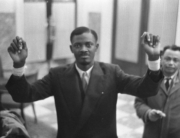
British filmmaker Jerry Rothwell’s rendition of Naoki Higashida’s 2007 best seller The Reason I Jump: The Inner Voice of a Thirteen-Year-Old Boy with Autism is a wholesome and educational experience that gives audiences a window into the minds of kids with autism. Rothwell’s film ambitiously illustrates the sensory-intense world of its subjects through the heightened sounds and super close-ups of the seemingly mundane everyday. This is less a straight adaptation of Higashida’s book and more a visual expansion that challenges preconceived notions of what is neurotypical.
Rothwell’s camera focuses on five autistic kids and their families. Amrit, a young woman in India, expresses herself through paintings that eventually land her an exhibition. Joss, a teen from England, is able to express his thoughts but struggles with aggression, which becomes a challenge for his parents. Two teenagers from the United States, Ben and Emma, attend an educational program that teaches them to spell out sentences they can’t verbalize by using letter boards. Then there’s Jestina, a girl from Sierra Leone who, with her tenacious parents, finds an educational community in what can be a hostile environment.
Among the close-ups of faces, drawings, and beams of lights that capture the world as experienced by the five subjects, there are narrated excerpts from Higashida’s musings that play over dramatic scenes of a young boy with autism exploring his surroundings. Rothwell films these segments as if it were visual poetry, using the boy as a vehicle for Higashida himself.
Patient and empathetic viewers will find much to learn from and be touched by in The Reason I Jump. In one fascinating scene, Ben and Emma utilize the communicative techniques taught to them in their lessons to formulate thoughts, dispelling notions that kids with autism lack “normal” rhetorical processing skills. Those of us with very little knowledge on the topic may even be embarrassed to discover that concepts like speech are more subjective vehicles for communication than we may realize.
Yet a question arises about some of the rhetorical techniques in both the film and Higashida’s book. Does everything the kids do have to be justified in poetic terms? Is a boy with autism really going outdoors because he’s “drawn to something outside,” according to the narrator, or does he just feel like going outside? Is he really drawn to something there or does he just feel like going outside? The film works best when it follows the subjects’ ordinary routines—when Joss is playing on a swing with his caretakers or when Ben and Emma are strolling through the park conversing.
Regardless, the film is a good starting point in getting viewers to realize the basic humanity and agency of kids with autism. It’s also a fascinating philosophical exploration on the subjective and objective nature of language and communication and the universal yearnings that belie the human experience.






Leave A Comment